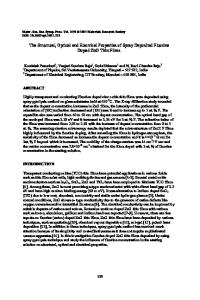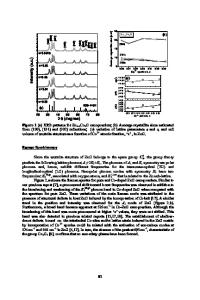Structural, optical and electrical properties of the novel semiconductor alloy ZnO x Te (1-x)
- PDF / 167,315 Bytes
- 6 Pages / 612 x 792 pts (letter) Page_size
- 65 Downloads / 357 Views
M5.5.1
Structural, optical and electrical properties of the novel semiconductor alloy ZnOxTe(1-x) H. L. Porter*, C. Jin, J. Narayan Department of Materials Science and Engineering North Carolina State University, Raleigh, NC 27695 A. L. Cai, J. F. Muth Department of Electrical and Computer Engineering North Carolina State University, Raleigh, NC 27695 O. W. Holland Solid State Division Oak Ridge National Laboratory, Oak Ridge, TN 37831
ABSTRACT Epitaxial films of undoped ZnOxTe(1-x) have been prepared on double-side polished c-axis oriented sapphire substrates with pulsed laser deposition. The method of epitaxial growth is expected to have the same domain matching epitaxial relationship with sapphire as does pure ZnO, where six lattice planes of ZnOxTe(1-x) match with seven lattice planes of sapphire [1,2]. High quality, single crystal, epitaxial alloys with around 4% Te have been grown that demonstrate excellent optical properties and a pronounced, sharp excitonic peak, in optical transmission. The incorporation of Te makes the compound more covalent, and less ionic than pure ZnO. Transmission electron microscopy (TEM) demonstrates single-crystal growth with a sharp interface. The low-resolution X-ray diffraction (XRD) pattern of ZnOxTe(1-x) films is almost indistinguishable from those of pure ZnO, except a usually diminished intensity of the (0004) peak. The incorporation of Te in ZnO was verified by a shift in excitonic peak position in absorption, and through a shift in cathodoluminescence (CL) peak. X-ray photoelectron spectroscopy (XPS) data verifies incorporation of telluride chemical state of tellurium atoms. Rutherford backscattering/channeling (RBS/C) confirmed crystal quality for the pure ZnO films. Hot-point probe measurements indicate as-grown, undoped films to be somewhat higher in resistivity than pure ZnO with inconclusive carrier type, as compared to the naturally n-type ZnO. This may be a consequence of the more covalent bonding between Zn and Te and suggests a possible strategy for p-type doping.
INTRODUCTION There is substantial interest in the development of wide band gap semiconductors for a variety of opto-electronic applications [3]. The recent developments in the GaN material system have led to the commercialization of high brightness LED’s and and blue diode lasers [4]. ZnO is an interesting alternative material system for light emitters due to its high oscillator strength and high binding energy of its exciton. However, ZnO is hard to dope p-type and efficient bipolar devices have yet to be realized.
* Corresponding author: [email protected]
M5.5.2
In this paper we report on incorporating low percentages of Te in ZnO to form ZnOxTe(1-x) alloys. We have found that thin films with good optical quality can be grown and that the electrical properties can be altered. While the films are not conclusively p-type we suspect that the incorporation of Te may be compensating unintentional donors, resulting in more intrinsic films. This suggests a possible strategy for p-type doping.
Data Loading...










